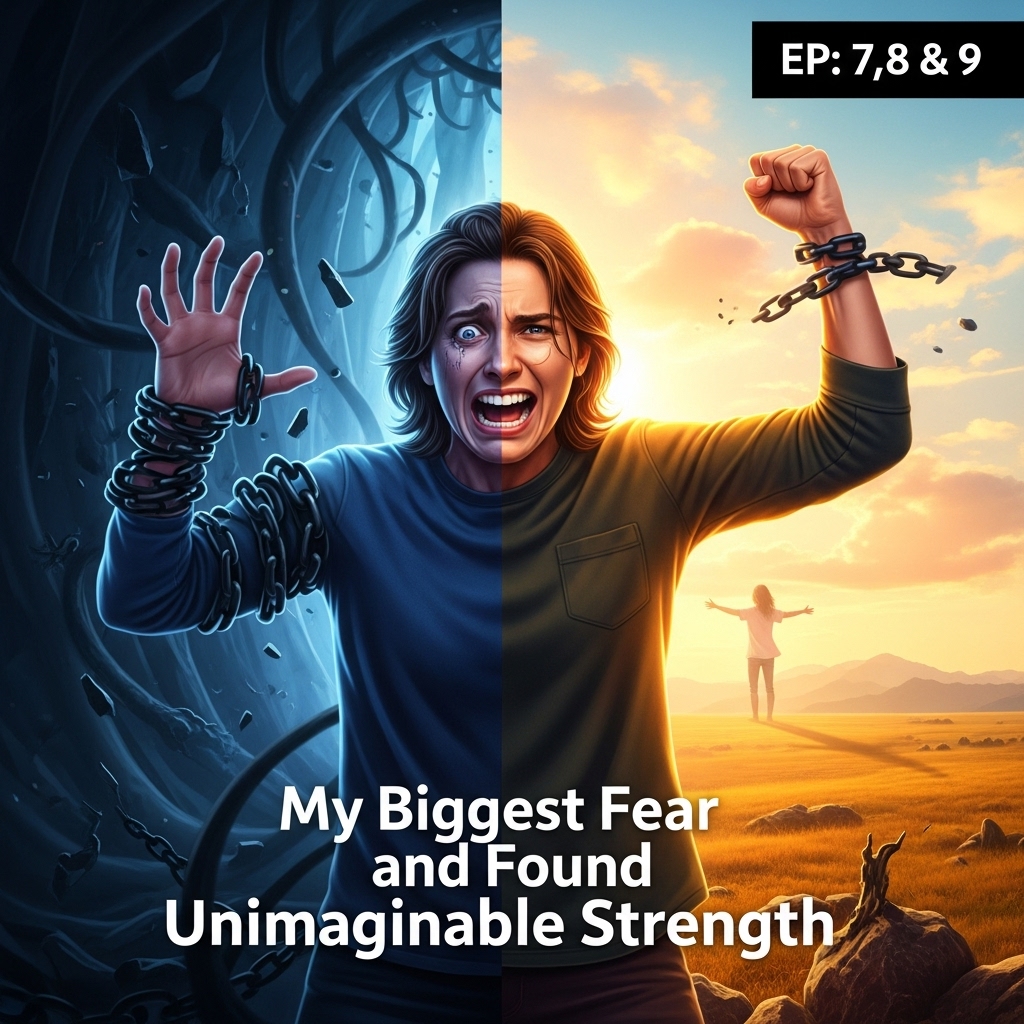Episode: 7
This period was marked by anintense internal monologue, a constant negotiation with myself. One part of me, the nascent courageous self, would argue: *You know this isn’t serving you. You know you want more. Just try again, a little differently this time.* Andthen the other part, the voice of the shadow, would interject: *What’s the point? It’s too painful. You’ll only get hurt again. Just accept who you are and stop trying to be someone you’renot.* The exhaustion of this constant battle was immense. It was a war of attrition, and in those early days, the shadow seemed to be winning, its whispers of doubt and resignation growing louder with each failed attempt.
I began to realize thatmy approach was flawed. I had treated the fear like an external enemy to be confronted head-on, a brute force problem that could be solved by sheer willpower and intellectual understanding. But the shadow was far more nuanced. It wasn’t just abarricade; it was an entire ecosystem, a deeply entrenched system of beliefs, habits, and physiological responses that had been reinforced over a lifetime. Trying to tear it down with a single, direct assault was akin to trying to fell an ancientforest with a single axe swing. It required more than just knowing *what* needed to change; it required a profound shift in *how* I approached the process of change itself.
The setbacks were painful, yes, but they werealso invaluable, though I couldn’t see it at the time. Each retreat, each wave of self-doubt, each moment of giving in to avoidance, provided crucial data. What specifically triggered the intense anxiety? What was the exact thought that ledto the retreat? How did my body react? By observing these patterns, even in my failures, I was inadvertently deepening my understanding of the shadow’s tactics, its weaknesses, and its most potent weapons. It was a slow, agonizingprocess of learning through repeated, often humiliating, trial and error.
One of the most insidious lessons was the trap of perfectionism. I expected that once I understood the “blueprint,” my attempts to dismantle the fear would be clean, efficient, and successful. Any deviation from this perfect trajectory was interpreted as a catastrophic failure, proof that I was fundamentally incapable. This all-or-nothing thinking became another weapon the shadow wielded against me. If I couldn’t do it perfectly, Ishouldn’t do it at all. This mindset made every small misstep feel like a reason to abandon the entire endeavor. The fear of not being good enough became the fear of *trying* and not being good enough, creating a paralyzing double bind.
The desire to give up was constant. There were days, weeks even, where I would completely capitulate, reverting to my old, comfortable patterns. I would avoid social situations, keep my opinions to myself, shyaway from anything that felt remotely challenging or vulnerable. In these moments of retreat, there was a strange, temporary comfort. The noise of the internal battle would subside. The anxiety would dissipate. But it was a false peace, hollow and unsatisfying. The underlying emptiness, the pervasive sense of being unfulfilled, would quickly return, stronger than before, often accompanied by a renewed wave of self-loathing for having given up. This cycle of trying, failing, retreating, and then regretting the retreat, became a painful testament to the shadow’s enduring power.
It was during one particularly low point, after another public attempt to voice an idea had been met with a polite but firm rejection, that I found myself staring at myreflection. The face staring back at me was tired, drawn, and held a profound sadness in its eyes. It wasn’t just the sadness of failure, but the sadness of resignation. I saw the fear, not just in the past, but actively etched into my present. I realized, with a chilling clarity, that I couldn’t continue this way. The current strategy of sporadic, ill-prepared frontal assaults on the shadow was not working. In fact, it wasstrengthening it, confirming its power, and draining my own limited reserves of courage.
The intellectual understanding had been the ignition, the spark that lit the flame of possibility. But the subsequent “first forays” had revealed the sheer magnitude of the task,the depth of the conditioning, and the cunning resilience of the fear itself. It wasn’t enough to know *what* to do; I clearly didn’t know *how* to do it effectively. The pain of repeated setbacks, the constantinternal battle, and the pervasive sense of being stuck began to point to a crucial truth: I couldn’t do this alone, and I couldn’t do it with the same mindset that had created the problem in the first place.
This realization, born out of the rubble of repeated failures, was itself a pivotal moment. It was the dawning awareness that courage wasn’t about the absence of fear, or even about always succeeding in confronting it. It was about continuing to seeka path forward, even when every fiber of my being screamed for retreat. It was about acknowledging the depth of the challenge and understanding that a new approach was not just desirable, but absolutely essential. The “first forays,” despite their painful outcomes, had served their purpose: they had shown me the battleground, revealed the enemy’s strength, and, most importantly, exposed the inadequacy of my initial strategies. I was battered, bruised, and disheartened, but I was also, ina strange and subtle way, much wiser about the nature of the beast I was fighting. The time for solo, unguided expeditions was over. It was time for a different kind of preparation, a different kind of courage, and a different kindof help.With the blueprints in hand, the initial burst of hope was intoxicating. It was like standing before a complex, imposing structure that had held me captive for so long, suddenly seeing the faint, almost invisible lines where the mortar was weakest, where abrick *could* be removed. The intellectual understanding, the painstaking self-archaeology, had provided a map, a theory, a grand strategy. The next logical step, I told myself, was to put that theory into practice.It felt like an urgent, exhilarating call to action, a mandate from my newfound, nascent self.
My first forays were tentative, almost experimental. They weren’t grand, dramatic gestures visible to the world, but small, internalskirmishes fought in the quiet theater of my own mind and in low-stakes social situations. I started with the most accessible “bricks” in my self-made prison: the small, daily acts of self-effacement, the ingrainedhabits of agreement, the instinct to fade into the background.
Episode: 8
One of the earliest attempts involved something as seemingly trivial as ordering coffee. For years, I had a specific, somewhat complicated coffee order, but more often than not, I woulddefault to a simpler, less desired option if the line was long, if the barista seemed busy, or if I just felt a prickle of self-consciousness. My fear told me: *Don’t bother them. Don’tbe a nuisance. Your preferences aren’t important enough to warrant extra effort.* So, my first “foray” was to simply order *my* coffee, exactly as I liked it, without apology or hesitation. The tremor in myvoice as I articulated “a large iced latte with oat milk, two pumps of sugar-free vanilla, and a single shot of espresso” felt disproportionate to the task. It was just coffee. But in that moment, it was a declaration. And when the barista didn’t scowl, didn’t roll their eyes, but simply nodded and typed it in, a tiny, almost imperceptible shift occurred. It was a victory, minuscule but real.
Encouragedby such small triumphs, I began to push a little further. I tried to voice a genuine opinion in a casual conversation with a friend, rather than just agreeing. I attempted to initiate a social gathering, something I almost never did, alwayswaiting to be invited. These were not challenges that would make headlines, but for someone whose fear had manifested as a constant suppression of self, they felt monumental. Each small act was a tiny chip away at the edifice of my constructed personality,a whisper of authenticity pushing through the practiced facade.
But the “shadow,” as I had come to call my deep-seated fear, was not so easily vanquished. It had spent decades weaving itself into the very fabric of my being, and it possessed an insidious intelligence. It didn’t just disappear because I understood its origins. It fought back. And it fought back with cunning, with subtlety, and with a particular mastery of psychological warfare.
The inevitable setbacks beganto accumulate, chipping away at my nascent hope with a relentless precision that often felt more debilitating than the initial fear itself. I remember one specific instance, early on, when I attempted to be more assertive in a work meeting. My fear ofjudgment, of appearing foolish or incompetent, had always kept me quiet, observing rather than participating actively. I’d sit there, ideas bubbling in my mind, perfectly valid points, yet they’d die on my tongue. This time,armed with my new understanding, I resolved to speak up.
I rehearsed my points internally, bolstered by the conviction that my perspective was valuable. When the opportunity arose, I took a deep breath, and I spoke. The words cameout, perhaps a little too fast, a little too strained, but they were out. And then, a colleague, someone whose opinion I valued, responded with a dismissive wave of their hand and a curt, “I think we’ve already covered that, haven’t we?” They weren’t overtly hostile, but the casual dismissal felt like a physical blow. The blood rushed from my face. My carefully constructed argument crumbled, not because it was flawed, but becausethe delivery was still fragile, and the reception was not what I had hoped for.
In that moment, the shadow resurfaced with a vengeance. It whispered, *See? I told you so. You’re not smart enough.Your ideas aren’t original. You should have just stayed quiet. You’re bothering people.* The shame was immediate and overwhelming. It wasn’t just disappointment; it was a profound sense of humiliation, a confirmation of every negative beliefI had ever held about myself. I felt my energy drain away, replaced by a cold, heavy blanket of self-doubt. For the rest of that meeting, I shrank, retreating deeper into myself than before. The fragile brick I hadtried to remove seemed to snap back into place with reinforced steel, trapping me more firmly than ever.
The immediate aftermath of such setbacks was a predictable spiral. The initial rush of self-reproach would quickly morph into a profound senseof weariness. *Why bother?* my mind would argue. *It’s too hard. This is just who you are. You can’t change this fundamental part of yourself.* The siren call of retreat, of returning tothe false security of my old patterns, was incredibly powerful. The emotional cost of trying and failing felt exponentially higher than the discomfort of simply enduring my previous state. At least before, there was a predictable misery; now, there was the addedsting of hope dashed.
Another attempt, this time more personal, involved a nascent interest I had in painting. It was a creative outlet I’d always yearned for but never pursued, primarily because of a deep-seated fear ofimperfection and judgment. My inner critic, fueled by the shadow, would always scoff: *You’re not artistic. You’ll only make a mess. What if someone sees it? It will just be another proof of your inadequacy.*Despite this, I bought some paints, a canvas, and a beginner’s guide. My first few attempts were tentative, exploring colors and textures in secret, feeling a flicker of joy. But then, I decided to show one of mypaintings to a trusted friend, hoping for encouragement, for validation.
Her response, while not overtly critical, was lukewarm. “Oh, that’s… interesting,” she said, her tone lacking any genuine enthusiasm. “It’scertainly… expressive.” The words, meant to be kind, landed like a judgment. They didn’t confirm my fears of outright failure, but they certainly didn’t offer the affirmation I desperately craved. And just like that, thejoy dissipated. The shadow seized the opportunity. *See? It’s not good enough. You’re not good enough. You should have known better than to put yourself out there.* I put the brushes away. The canvas sat untouchedin a corner for months, a silent testament to another failed “foray.” The desire to create was still there, but the courage to express it openly had evaporated, replaced by the familiar ache of disappointment.
These were the patterns:moments of hesitant bravery followed by sharp, painful retreats. The setbacks weren’t always external; sometimes, the most brutal battles were fought entirely within my own head. I would commit to a new, vulnerable action—say, attending a socialevent where I didn’t know many people—and as the date approached, the internal resistance would mount. My mind would conjure vivid scenarios of awkwardness, of being ignored, of saying the wrong thing. My body would respond with familiaranxiety: a racing heart, shallow breathing, a churning stomach. More often than not, I would find an excuse to cancel, or arrive late and leave early, or simply remain quiet and observe, safely hidden behind my practiced mask. Eachretreat, each decision to avoid the discomfort, felt like a small surrender, reinforcing the power of the shadow and deepening the grooves of my old habits.
The most frustrating aspect was the feeling of being perpetually stuck in a loop. I understood*why* I was doing these things. I could trace the roots of my fear, identify the triggers, and even see the subtle ways my avoidance behaviors manifested. Yet, understanding wasn’t translating into consistent change. It was like knowingthe mechanics of a bicycle but still falling over every time I tried to ride it. The intellectual insight was powerful, but the practical application was proving to be a minefield of emotional traps.
Episode: 9
This period was marked by an intense internal monologue, a constant negotiation with myself. One part of me, the nascent courageous self, would argue: *You know this isn’t serving you. You know you want more. Just try again, a little differently this time.* And thenthe other part, the voice of the shadow, would interject: *What’s the point? It’s too painful. You’ll only get hurt again. Just accept who you are and stop trying to be someone you’re not.* The exhaustion of this constant battle was immense. It was a war of attrition, and in those early days, the shadow seemed to be winning, its whispers of doubt and resignation growing louder with each failed attempt.
I beganto realize that my approach was flawed. I had treated the fear like an external enemy to be confronted head-on, a brute force problem that could be solved by sheer willpower and intellectual understanding. But the shadow was far more nuanced. Itwasn’t just a barricade; it was an entire ecosystem, a deeply entrenched system of beliefs, habits, and physiological responses that had been reinforced over a lifetime. Trying to tear it down with a single, direct assault was akin totrying to fell an ancient forest with a single axe swing. It required more than just knowing *what* needed to change; it required a profound shift in *how* I approached the process of change itself.
The setbacks were painful,yes, but they were also invaluable, though I couldn’t see it at the time. Each retreat, each wave of self-doubt, each moment of giving in to avoidance, provided crucial data. What specifically triggered the intense anxiety?What was the exact thought that led to the retreat? How did my body react? By observing these patterns, even in my failures, I was inadvertently deepening my understanding of the shadow’s tactics, its weaknesses, and its most potent weapons. It was a slow, agonizing process of learning through repeated, often humiliating, trial and error.
One of the most insidious lessons was the trap of perfectionism. I expected that once I understood the “blueprint,” my attempts to dismantlethe fear would be clean, efficient, and successful. Any deviation from this perfect trajectory was interpreted as a catastrophic failure, proof that I was fundamentally incapable. This all-or-nothing thinking became another weapon the shadow wielded against me.If I couldn’t do it perfectly, I shouldn’t do it at all. This mindset made every small misstep feel like a reason to abandon the entire endeavor. The fear of not being good enough became the fear of *trying* and not being good enough, creating a paralyzing double bind.
The desire to give up was constant. There were days, weeks even, where I would completely capitulate, reverting to my old, comfortable patterns. I would avoidsocial situations, keep my opinions to myself, shy away from anything that felt remotely challenging or vulnerable. In these moments of retreat, there was a strange, temporary comfort. The noise of the internal battle would subside. The anxiety would dissipate.But it was a false peace, hollow and unsatisfying. The underlying emptiness, the pervasive sense of being unfulfilled, would quickly return, stronger than before, often accompanied by a renewed wave of self-loathing for having given up.This cycle of trying, failing, retreating, and then regretting the retreat, became a painful testament to the shadow’s enduring power.
It was during one particularly low point, after another public attempt to voice an idea had been metwith a polite but firm rejection, that I found myself staring at my reflection. The face staring back at me was tired, drawn, and held a profound sadness in its eyes. It wasn’t just the sadness of failure, but thesadness of resignation. I saw the fear, not just in the past, but actively etched into my present. I realized, with a chilling clarity, that I couldn’t continue this way. The current strategy of sporadic, ill-preparedfrontal assaults on the shadow was not working. In fact, it was strengthening it, confirming its power, and draining my own limited reserves of courage.
The intellectual understanding had been the ignition, the spark that lit the flame of possibility.But the subsequent “first forays” had revealed the sheer magnitude of the task, the depth of the conditioning, and the cunning resilience of the fear itself. It wasn’t enough to know *what* to do; I clearly didn’t know *how* to do it effectively. The pain of repeated setbacks, the constant internal battle, and the pervasive sense of being stuck began to point to a crucial truth: I couldn’t do this alone, and I couldn’t do it with the same mindset that had created the problem in the first place.
This realization, born out of the rubble of repeated failures, was itself a pivotal moment. It was the dawning awareness that courage wasn’tabout the absence of fear, or even about always succeeding in confronting it. It was about continuing to seek a path forward, even when every fiber of my being screamed for retreat. It was about acknowledging the depth of the challenge and understanding thata new approach was not just desirable, but absolutely essential. The “first forays,” despite their painful outcomes, had served their purpose: they had shown me the battleground, revealed the enemy’s strength, and, most importantly,exposed the inadequacy of my initial strategies. I was battered, bruised, and disheartened, but I was also, in a strange and subtle way, much wiser about the nature of the beast I was fighting. The time for solo, unguided expeditions was over. It was time for a different kind of preparation, a different kind of courage, and a different kind of help.The “first forays,” despite their painful outcomes, had served their purpose: they had shown me the battleground, revealed the enemy’s strength, and, most importantly, exposed the inadequacy of my initial strategies. I was battered, bruised, and disheartened, but I was also, in a strange and subtle way, much wiser about the nature of the beast I was fighting. The time for solo, unguided expeditions was over. It was time for a different kind ofpreparation, a different kind of courage, and a different kind of help.
This realization didn’t come as a sudden, glorious flash of insight, like a sunrise breaking through the darkest night. No, it was more akin to the slow,relentless erosion of a stubborn cliff face by the constant lapping of the ocean’s tide. Each failed attempt, each retreat, each fresh wave of despair, chipped away at the stubborn fortress of my self-reliance and the pride that insisted I could conquerthis alone. There was a deep-seated resistance within me to admitting defeat, to confessing that I wasn’t strong enough, clever enough, or resilient enough to face this particular monster on my own terms. My ego, you see, hadbeen a powerful, if ultimately unhelpful, ally in this battle. It whispered insidious suggestions: that seeking help was a sign of weakness, that it meant I had failed in some fundamental way, that I would be judged or misunderstood.



